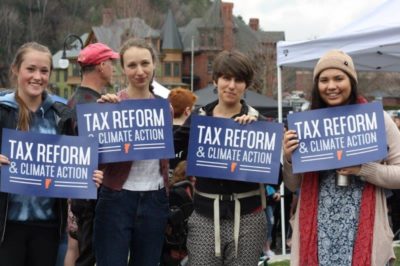The world needs to price carbon pollution. The country needs to price carbon pollution. Vermont needs to price carbon pollution! It’s the most efficient, effective and equitable path to reducing carbon pollution. It’s not a silver bullet, but it is essential. Without a carbon price none of our state’s climate goals are attainable.
And as the only state among our neighbors to increase carbon pollution since 1990, Vermont has an obligation to do more to address the climate crisis.
Thankfully, there are four carbon proposals under consideration in Montpelier. Here’s a synopsis of each:
Transportation & Climate Initiative (TCI): This is a multi-state program that, if enacted, would cover carbon emissions from transportation fuels and invest the proceeds “to achieve carbon emission reductions and other policy goals.” TCI is modeled on the Regional Greenhouse Gas Initiative (RGGI), which has been pricing carbon in the electric sector for more than a decade. On October 1, the TCI states released a Framework for a Draft Regional Policy Proposal and plan to issue a draft memorandum of understanding (MOU) in December with a final MOU expected in the spring of 2020, at which point each jurisdiction will decide whether to sign the final MOU and participate in the regional program.
Officials from the Vermont Agency of Natural Resources, VTrans and the Public Service Department are participating in the program design process, but Gov. Phil Scott is sending mixed signals about whether he will join the program next spring.
Vermont Carbon Fee & Rebate: Earlier this month, backed by detailed economic analysis, Burlington Mayor Miro Weinberger proposed a revenue-neutral carbon pricing program that would pay Vermonters millions, create hundreds of jobs and reduce carbon pollution. The plan is similar to The Vermont Case of Carbon Dividends, which was introduced as legislation in 2017.
Per the mayors office: “Under the revenue-neutral fee and rebate model that Mayor Weinberger proposed, virtually all of the revenue collected by the fee would be rebated back out to Vermont households and businesses. In this model, the State would apply a carbon fee to the purchase of all fossil fuels, and then rebate those revenues back to Vermont households and businesses, with a per capita rebate for every household and a rebate for businesses in proportion to how many jobs they support.”
The ESSEX Plan (H.463) Originally proposed by a collaboration of Vermont business and low-income community leaders in 2017 as a way to strengthen the economy, address income inequality, and reduce pollution, the Economy-Strengthening Strategic Energy eXchange (ESSEX) Plan was introduced as legislation by the current co-chairs of the Climate Solutions Caucus: Sen. Chris Pearson and Rep. Sarah Copeland-Hanzas.
In 2018 the legislature directed the Joint Fiscal Office to commission a $120,000 costs/benefits analysis of several carbon pricing proposals. Resources for the Future (RFF) conducted the study and forecast the ESSEX Plan would grow the economy, benefit low- and middle-income Vermonters, and reduce climate pollution faster than any other legislative proposal.
The Vermont Equity & Infrastructure Act (H.477): Introduced by Winooski Rep. Diana González in February 2019, H.477 is a 10-year plan to invest $1.6 billion in the local economy and put Vermonters to work. Proceeds would be used to:
- Weatherize 25,000 low-income homes
- Install 52,000 high-efficiency heat pumps
- Button up 1,300 school and municipal buildings
- Increase the Earned Income Tax Credit
- Create a new Rural Vermont Tax Credit
- Invest millions in rural transportation
- Provide incentives for 35,000 electric vehicles (EVs)
- Deploy 8,700 electric vehicle charging stations
H.477 has gained the most attention of young climate activists. You can watch some of them discussing the bill at the March 2019 Climate Strike here.
There are differences in coverage, rate, pace and investments between each of these proposals. But they all have something in common. All would benefit the economy and cut carbon pollution faster than business as usual.
With four good proposals on the table, the question for policymakers is not whether Vermont should price carbon pollution, but how.
What’s next?
You can help. Before the Legislature reconvenes in January is a great time to connect with your elected representatives and share your thoughts on the best path forward. Tell the governor and your legislators that Vermont should use a price on pollution to fund climate solutions. Then ask them what their climate plan is.
There will be public forums, webinars and open meetings this fall where you can weigh in. And you can always contact the governor and your legislators directly.
Now is the time! Working together we can convince Vermont policymakers to address the climate crisis with the most powerful tool in their toolbox: a price on carbon pollution.

